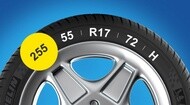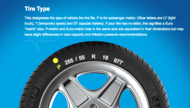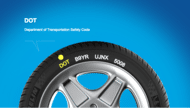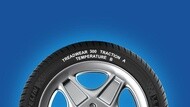
Auto Tips & Advice
Find your size on your tire

A tire’s sidewall is simply the outer and inner “walls” on the sides of a tire. Every sidewall has its own unique information that is divided into three main sections:
1. Tire Specs
This describes the fundamental characteristics of your tire. Size, construction, speed rating and more.


2. Department of Transportation Safety Code
This assures that your tire complies with all Department of Transportation (DOT) safety standards. After the DOT insignia is your tire’s identification number, which begins with the tire’s manufacturer and plant code where the tire was manufactured (two numbers or letters). The ninth and tenth characters tell the week the tire was manufactured. The final number(s) signifies the year the tire was manufactured.
3. UTQG code
The Uniform Tire Quality Grading (UTQG) was established by the National Highway Traffic Safety Administration (NHTSA) to test tires following government prescribed test methods and then grade each tire on three main components:
Treadwear: This is the wear rate of the tire, comparable only to other tires within a tire manufacturer’s line. 100 is the baseline grade. Therefore a tire with 200 would theoretically last twice as long on the government’s course compared to a tire with 100.
Traction: Traction grades are AA, A, B and C (with AA being the highest grade). They represent the tire’s ability to stop straight on wet pavement as measure on a specified government track. Any tire rated under C is considered unacceptable for road travel.
Temperature: The temperature grades, from highest to lowest, are A, B and C. These represent the tire’s ability to dissipate heat under controlled indoor test conditions. Any tire rated below C is considered unacceptable.


4. Icons
Some tires have unique benefits, as showcased with specific icons.
The letters M and S (M +S) indicate that the tire meets the Rubber Manufacturers Association’s standards for a mud and snow tire. The letters can be found in the following combinations: M+S, M/S, and M&S. All-season tires carry this mark.
Find your tire size in your vehicle owner’s manual or on your door
- Find the information in your vehicle owner’s manual in the glove compartment or on the tire information sticker on your driver’s side door.
- Usually those elements contain all the information related to your tire size and specifications as well as the appropriate tire pressure.
See the “Find your tire size on your tire” tab for a full description of the numbers and letters.
What are OE tires?
OE stands for “Original Equipment”, meaning that the tires were approved by your vehicle manufacturer to come standard on your vehicle.
Some vehicle manufacturers, such as Audi, BMW, Mercedes, and others, equip their vehicles with tires that are specifically made for their brand. These tires have a special OE marking on the sidewall. In this case, Michelin recommends to replace tires on your vehicle only with tires equipped with necessary OE marking. Table of OE markings by vehicle brand :
- * = BMW, Mini
- MO = Mercedes
- AO = Audi
- VO = Volkswagen
- N0, N1, N2, N3, N4 = Porsche
- MO1 = AMG
- RO1 = QUATTRO


Find a Dealer
Search by
Address, City or ZIP code

